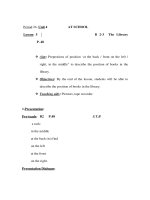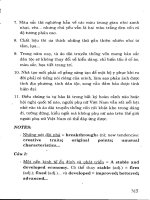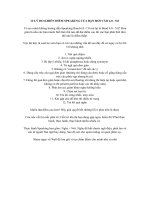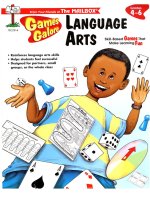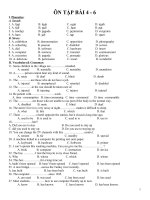4 6 5 one giant step
Bạn đang xem bản rút gọn của tài liệu. Xem và tải ngay bản đầy đủ của tài liệu tại đây (6.82 MB, 14 trang )
Suggested levels for Guided Reading, DRA,™
Lexile,® and Reading Recovery™ are provided
in the Pearson Scott Foresman Leveling Guide.
Space and Technology
One Giant
Step
Genre
Narrative
nonfiction
Comprehension
Skills and Strategy
• Graphic Sources
• Cause and Effect
• Monitor and Fix Up
Text Features
•
•
•
•
Captions
Labels
Diagrams
Glossary
Scott Foresman Reading Street 4.6.5
ISBN 0-328-13500-3
ì<(sk$m)=bdfa e< +^-Ä-U-Ä-U
by Sharon Franklin
Vocabulary
astronauts
capsule
hatch
horizon
lunar
Reader Response
One Giant Step
1. What graphic sources did you see used in this
book? Why did the author include them?
2. Did you have any questions about the order of
events in the takeoff? Try rereading sections to
by
find answers.
FillSharon
in a chartFranklin
similar to the one
below with your questions and answers.
Questions
Answers
module
quarantine
Word count: 2,570
3. Find the word tether on page 18. Use context clues
to figure out what this word means.
4. How do the italicized words on pages 3 and 4
draw readers into the book?
Note: The total word count includes words in the running text and headings only.
Numerals and words in chapter titles, captions, labels, diagrams, charts, graphs,
sidebars, and extra features are not included.
Editorial Offices: Glenview, Illinois • Parsippany, New Jersey • New York, New York
Sales Offices: Needham, Massachusetts • Duluth, Georgia • Glenview, Illinois
Coppell, Texas • Ontario, California • Mesa, Arizona
July 16, 1969
The Apollo 11 crew
Every effort has been made to secure permission and provide appropriate credit for
photographic material. The publisher deeply regrets any omission and pledges to
correct errors called to its attention in subsequent editions.
Unless otherwise acknowledged, all photographs are the property of Scott Foresman,
a division of Pearson Education.
Photo locators denoted as follows: Top (T), Center (C), Bottom (B), Left (L), Right (R),
Background (Bkgd)
Opener: Getty Images, (B) ©John F. Kennedy Space Center/NASA Image Exchange;
1 NASA; 3 NASA; 5 ©John F. Kennedy Space Center/NASA Image Exchange; 6 Getty
Images, (T) NASA Image Exchange; 7 NASA; 8 NASA Image Exchange; 9 NASA; 10
NASA; 11 NASA, (B) Corbis; 12 NASA, Corbis; 13 Bettmann/Corbis; 14 NASA/Photo
Researchers, Inc.; 15 (CL) Getty Images, (B) DK Images; 17 NASA; 19 Getty Images; 21
(T) NASA, (C) Getty Images, (B) Corbis; 22 NASA; 23 Corbis
ISBN: 0-328-13500-3
Copyright © Pearson Education, Inc.
All Rights Reserved. Printed in China. This publication is protected by Copyright,
and permission should be obtained from the publisher prior to any prohibited
reproduction, storage in a retrieval system, or transmission in any form by any
means, electronic, mechanical, photocopying, recording, or likewise. For information
regarding permission(s), write to: Permissions Department, Scott Foresman, 1900 East
Lake Avenue, Glenview, Illinois 60025.
4 5 6 7 8 9 10 V0H3 14 13 12 11 10 09 08 07 06
“12 . . . 11 . . . 10 . . . 9 . . . Ignition sequence starts.”
People hold their breath as a huge ball of flame appears
at the base of the Saturn V booster rocket. The Saturn
V will propel the Apollo 11 astronauts into space. It is
so tall that the astronauts had to use an elevator to get
to the spacecraft at the top of the rocket.
“6 . . . 5 . . .” Steam from the launch site billows up,
producing huge clouds that cover the area around the
launch pad. People watching grow strangely quiet. No
one says a word.
“4 . . . 3 . . .” The shudder from the launch pad is
felt miles from the Kennedy Space Center in Florida.
The two million people who crowd the nearby
grandstands, roads, and beaches to see
the launch feel it. A different kind of
shudder is felt by the astronauts’ families
and everyone at Mission Control in
Houston, where the space shuttle flight is
monitored. Millions of people around the
world watch and listen.
3
No one feels the excitement more than the three
astronauts on board Apollo 11. The day is finally here
for Neil A. Armstrong, Michael Collins, and Edwin E.
“Buzz” Aldrin, Jr. It is the morning of July 16, 1969.
They have prepared carefully and are on their way to
the moon.
“2 . . . 1 . . . 0 . . . All engines running. Liftoff! We have a
liftoff, thirty-two minutes past the hour. Liftoff on Apollo 11 . . .
Tower cleared!”
People on the ground cheer, clap, cry, hug, and
scream with joy—responses echo around the
world. The Saturn V slowly moves into its
correct flight path.
Over the next eight days, the
astronauts of the Apollo 11 space
capsule will land a craft on the moon,
go out to walk on the lunar surface,
and then return to Earth. Some people
called it the biggest single step in
human history.
People watching on the beach
shield their eyes and strain to see the
spacecraft in the sky until it disappears.
They pack up their blankets and picnic
baskets and prepare to leave. But inside
the command module of Apollo 11,
the hard work is just beginning.
4
Less than three minutes after liftoff, the first stage
of the Saturn V burns the last of its fuel and falls away.
The loss of thrust hurls the astronauts forward. Luckily,
they are held in place by their straps. Moments later
the second stage erupts, burning its fuel and slamming
the astronauts back into their seats by the force of the
acceleration. When the second stage separates from
the command and service modules, the men are thrust
forward again. Once out of Earth’s gravity, they are
weightless.
The Saturn V
Launch Vehicle
The Saturn V launch vehicle,
used in the Apollo 11 space
mission, had three stages,
or sections, each with its
own powerful engines and
fuel. The stages fell away
from the spacecraft when
their fuel had been used up.
They burned up as they fell
back to Earth through the
atmosphere.
5
The Voyage of Apollo 11
3
2
1. Launches and
orbits Earth
1
4
2. Orbits and lands
on the moon
3. Takes off from
the moon
4. Returns back home
Now it is time for Michael Collins to separate the
command module Columbia and its service module from
the third stage of Saturn, turn around, and connect with
the lunar module Eagle, stored in the remaining section
of the Saturn V. The lunar module is the vehicle that
will land on the moon. Unless the two spacecraft are
docked correctly, Aldrin and Armstrong will not be able
to enter the lunar landing module.
Everything goes perfectly. Columbia’s nose makes a
clean connection to the top of the Eagle. It heads for the
moon, and Saturn’s third stage moves slowly away. At
this point the three astronauts have been working for
fourteen hours straight since the time of liftoff. They’ve
earned a rest and go to sleep at 10:30 P.M.
6
July 17
About 9 A.M., the crew eats breakfast. There is no
newspaper delivery in space, so Mission Control gives
them a summary of the day’s news, including sports!
They successfully test the engine that will carry them
into lunar orbit so they can land on the moon.
Shortly after 7:30 P.M., they begin a thirty-six minute
color TV broadcast from the spacecraft. Viewers on
Earth can see the inside of the command module.
July 18
Mission Control lets the astronauts sleep an extra
hour. After breakfast, they check fuel levels, charge
batteries, and dump waste water into space. They
give another TV broadcast later in the day, talking to
the people back home for over an hour and a half. As
viewers watch, the hatch to the lunar module is opened.
Commander Armstrong, followed by Buzz Aldrin,
squeezes through the small tunnel to inspect the Eagle.
Buzz Aldrin
7
The moon as seen
from Apollo 11
A little before 4 P.M., they begin a thirty-five minute
telecast of the moon’s surface. The camera shows the
area chosen as the Eagle’s landing site. Armstrong and
Aldrin test the Eagle once again. They set out all the
clothing and equipment they will need for their walk on
the moon tomorrow.
This photo of Earth rising over the lunar horizon is
one of the most famous photos taken during any space
flight. As the astronauts look at planet Earth from space,
what thoughts do they have? Do they wonder how all
three of them got to this shared place in history?
July 19
The astronauts wake up early but are told they
can sleep for another hour and a half. After breakfast,
housekeeping chores, and the daily news report, the
astronauts see the moon. They have not been able to
see it for almost a whole day. It now appears much
larger and closer through the window of Columbia, a
sight no one on Earth has ever been able to see.
Soon the astronauts pass around the moon. They are
ready for the first engine burn. The burst slams the men
back in their seats. This burn ends after six minutes.
A second burn will place them in an orbit closer to
the moon. Then Armstrong and Aldrin will prepare
to separate from the Columbia and land on the moon’s
surface in the Eagle. These burns must be perfect.
Luckily, because of great care and practice, both burns
go very well.
8
Earth rising over the lunar horizon
9
The Apollo 11 Crew
During the Korean War, Armstrong
flew fighter jets. His seventy-eight
combat missions earned him three
medals. He later completed college
degrees in aeronautical engineering and
aerospace engineering. As a NASA pilot,
he tested the F-102 supersonic fighter and
the X-15 rocket plane.
Neil Armstrong was selected as an astronaut in
1962. Four years later, he commanded space flight
Gemini 8. Each step of his career inched him closer to
his role as commander of Apollo 11 and one of the two
men who would land and walk on the moon.
From left to right: Commander Neil A. Armstrong,
command module pilot Michael Collins, lunar module
pilot Edwin E. “Buzz” Aldrin, Jr.
Neil Armstrong
Neil Armstrong
Neil A. Armstrong was born on his grandparents’
farm in Ohio. He fell in love with flying after he saw an
Ohio air show with his father. He was inspired to fly at
seven years old after he took his first airplane ride in the
“Tin Goose,” one of the first all-metal planes to carry
passengers.
As Neil grew older, his love of flying also grew. He
built model airplanes and made a wind tunnel in the
family basement to test them. He read every book on
flying he could find. At age fifteen, he started working
to make enough money for flying lessons. He earned
his pilot’s license just one year later, at sixteen.
10
11
Edwin “Buzz”
Aldrin at age 3
Michael Collins
Michael Collins
Edwin “Buzz” Aldrin
Edwin Aldrin was born in Montclair, New Jersey,
on January 20, 1930. He played in the park, learned
to pole vault, and loved football. Aldrin went to West
Point after high school and, like Armstrong, flew
combat missions in Korea.
Aldrin was turned down the first time he applied for
the astronaut program, but he didn’t give up. In 1963,
after earning an advanced degree in astronautics, Aldrin
was accepted as a NASA astronaut. He found the space
program very different from flying combat missions in
Korea. In combat, Aldrin explained, you have to make
snap decisions and constantly respond quickly to the
unknown. In space, it is very different. You learn to
make slow, carefully thought-out decisions and try hard
to avoid making mistakes. He was perfectly suited to
his job on Apollo 11. He piloted the lunar module that
carried him and Neil Armstrong to the moon and back
again. He also walked on the moon.
12
Michael Collins was born in Rome, Italy, on
October 31, 1930. He later moved to Washington,
D.C. Collins had much in common with Armstrong
and Aldrin. He also chose flying as a career. After
graduating from West Point, he tested jet fighters for the
Air Force. Collins spent a lot of time in the sky, logging
over four thousand hours of flying time.
Collins was named a NASA astronaut in 1963.
He was the backup pilot for the Gemini 7 mission
and a pilot on the Gemini 10 mission, in which he
docked with another spacecraft. During Apollo 11,
Michael Collins’s job was to command the Columbia
and continue to orbit the moon while Armstrong and
Aldrin descended to the lunar surface in the Eagle,
and then successfully dock with the lunar module and
return home.
Just as the backgrounds of his fellow astronauts
helped pave their way to the moon, Collins’s life
experiences helped him. As pilot on Apollo 11, Collins
succeeded with flying colors.
13
The men are six thousand feet above the surface
when a yellow caution light flickers to life. Luckily,
Mission Control assures them there is nothing to
worry about. At 4:18 P.M., the Eagle lands at the Sea
of Tranquility, an area of the moon filled not with
water but with dark solidified lava. Armstrong reports
the welcome news to Mission Control: “Houston,
Tranquility base here—the Eagle has landed.”
Houston later finds out that Armstrong’s quick
decisions saved the Eagle as he took control and piloted
it to a safe landing location, avoiding a field of boulders
and a large crater. After landing, they had less than
thirty seconds of fuel left.
“The Eagle Has Landed!”
On July 20, 1969, just four days after liftoff,
Armstrong and Aldrin open the hatch between Columbia
and Eagle. They float into the craft and prepare it for its
flight to the lunar surface. Everything looks good. Later
that day, the lunar module Eagle is ready to separate
from the Columbia.
Armstrong and Aldrin slowly separate from the
command module and, strapped in a standing position,
begin their slow descent to the lunar surface.
The lunar module Eagle has four legs dangling
awkwardly in all directions from its body. On the Eagle
with the astronauts are some scientific instruments that
they will place on the moon’s surface.
14
The Eagle is now separated
from the Columbia.
15
“One Giant Leap for Mankind”
The two men are supposed to rest after landing, but
they are too excited to sleep. They decide to walk on
the moon earlier than planned.
It still takes hours to get ready. In fact, it takes them
over two hours just to get their 180-pound spacesuits
on, even without the pull of Earth’s gravity. A little
over six hours after landing, Neil Armstrong slowly
squeezes through the hatch. He has a life support and
communication system strapped to his shoulders.
He moves slowly down the nine steps of the ladder,
stopping on the last step before putting his left foot on
the lunar surface. He is now the first human to walk on
the moon. As he takes his first step, millions of people
watching back on Earth hear him speak these now
famous words:
“That’s one small step for man, one giant leap for
mankind.”
Aldrin backs out of the spacecraft onto the lunar
surface, and the two men spend the next few hours
collecting moon rocks, drilling core samples, and
taking photographs. They test ways of moving around,
including kangaroo hops on two feet. They figure out
that an easy run is the best way to move.
Armstrong and Aldrin plant the U.S. flag on the soil
and take a phone call from President Richard Nixon.
The men also leave a plaque on the moon. The plaque
reads:
HERE MEN FROM THE PLANET EARTH
FIRST SET FOOT UPON THE MOON
JULY 1969 A.D.
WE CAME IN PEACE FOR ALL MANKIND
Because there is no wind
or water to wear away
the moon’s surface, the
footprints left by the
astronauts in the Sea of
Tranquility will probably
last for millions of years.
16
17
Emergency oxygen
The Spacesuit
In earlier space flights, men walked in space with
a tether that attached their spacesuit to the spacecraft.
For Apollo 11, the suit design needed to change to both
protect the astronauts and give them freedom to bend,
lift, and walk on the rough ground. Each of the nine
parts of these suits was designed for a specific purpose.
Life support—controls the oxygen, pressure,
ventilation, and communication
Emergency oxygen—provides backup in case the
main life support unit fails
Helmet—anchored to the suit, but astronauts can
turn their heads side to side inside the helmet
Visors—protect the astronauts’ eyes from ultraviolet
radiation and seal oxygen inside
Gloves—made from casts of the astronauts’ hands
to increase flexibility
Joints—molded rubber joints added at bending
parts of the body make it possible for the astronauts to
move and walk freely to conduct experiments
Layered suit—several layers to protect, insulate,
and ventilate their bodies
Neck ring—attaches the helmet to the space suit
Boots—include an overshoe designed to fit over the
spacesuit boot
Helmet
Visors
Neck ring
Gloves
Life support
Joints
Layered
suit
Boots
18
19
Armstrong and Aldrin spend less than one Earth day
on the moon’s surface. The actual moonwalk lasts just
two and one-half hours, yet it changes everything. The
dream of touching the moon has become a reality.
The astronauts return to the lunar module and get
some sleep. About seven hours later Mission Control
awakens them. It’s time to redock with the Columbia.
Back in the Columbia, Michael Collins is nervous.
What if the Eagle’s engine won’t start? What if the
docking doesn’t happen and something goes wrong? He
does not want to think about returning to Earth without
his fellow travelers. But he does not have to worry.
Shortly before 2:00 P.M. on July 21, the Eagle’s engine
fires, lifting Armstrong and Aldrin off the lunar surface.
Eagle successfully redocks with the Columbia. Aldrin and
Armstrong join Collins. The Eagle’s job is done. It won’t
return to Earth with the Columbia. It will drift off as
planned, remaining in lunar orbit to this day.
Apollo 11 splashes down in the Pacific Ocean on
July 24, 1969. The astronauts spend three weeks in
quarantine, or isolation, while scientists make sure that
they have not brought back any germs from the moon.
They can finally greet their families and the world in
August.
20
Apollo 11
splashes down
into the Pacific
Ocean.
The Apollo 11 crew
speaks to President
Richard Nixon while
in quarantine.
The astronauts are
honored with a
parade in New York.
21
Since Apollo 11
After Apollo 11, Neil Armstrong worked at
NASA and taught engineering. He also served on the
Presidential Commission that investigated the explosion
of the Challenger spacecraft.
After Apollo 11, Buzz Aldrin returned to the Air
Force and then retired a year later. He worked with
NASA’s Lunar-Mars Exploration Office. He has written
books about space, including Return to Earth, about the
flight of Apollo 11, and a science-fiction book, Encounter
with Tiber. He also developed a plan for connecting Mars
and Earth by using a constantly moving spacecraft.
After leaving NASA in 1970, Michael Collins ran the
National Air and Space Museum in Washington, D.C.,
for several years. He has written Carrying the Fire and
Flying to the Moon and other Strange Places.
Apollo 11 was a huge step. Each generation must
continue to move forward, rise to challenges, and
achieve its goals. In your time, what do you think that
next giant step will be?
People visit the
Apollo 11 command
module inside the Air
and Space Museum in
Washington, D.C.
22
23
Glossary
Vocabulary
astronauts
astronauts n. members
of the crew of a
capsule
spacecraft.
capsule
n. the enclosed
hatch
front section of a
rocket made to carry
horizon astronauts,
instruments,
etc., into space.
lunar
hatch n. a trapdoor
covering an opening
module
in an aircraft’s or ship’s
deck; hatchway cover.
quarantine
Reader Response
lunar adj. of, like, or
about the moon.
1. What graphic sources did you see used in this
book? Why did the author include them?
module n. a selfcontained unit or system
within a larger system,
often designed for a
particular function.
2. Did you have any questions about the order of
events in the takeoff? Try rereading sections to
find answers. Fill in a chart similar to the one
below with your questions and answers.
quarantine n.
detention, isolation, and
other measures taken
to prevent the spread of
an infectious disease.
horizon n. the line
where land and sky
seem to meet; skyline.
Word count: 2,570
Questions
Answers
3. Find the word tether on page 18. Use context clues
to figure out what this word means.
4. How do the italicized words on pages 3 and 4
draw readers into the book?
Note: The total word count includes words in the running text and headings only.
Numerals and words in chapter titles, captions, labels, diagrams, charts, graphs,
sidebars, and extra features are not included.
24

